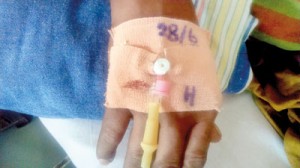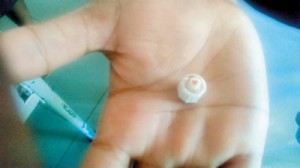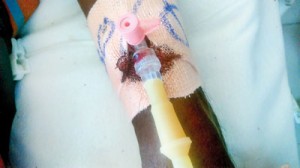News
Overcoming dengue, but hit by deadly super-bug– MRSA
Watch out for a secondary infection after dengue, especially a dangerous hospital-acquired ‘super-bug’ which can cause death.
This is the red alert being sent out by Consultant Microbiologist Dr. Muditha Abeykoon of the Polonnaruwa Hospital who has confirmed eight such cases, of whom tragically one had died.

Cannula on a patient to administer saline or medication. The elastoplast is not transparent, so it is difficult to spot any redness which would indicate an infection
All these patients had been treated for dengue either at the Polonnaruwa Hospital or another hospital, had recovered and been discharged.
They had re-sought admission after some time as they were ill once again.
The secondary illness was due to the super-bug — Methicillin-resistant Staphylococcus aureus (MRSA), a hospital-acquired drug-resistant infection, warns Dr. Abeykoon who had performed blood cultures on all eight patients which confirmed the infection.
“All of them had got the secondary MRSA infection from the cannula site,” he said, underscoring that the point of entry of the bug or bacterium was this site.
This bacterium can cause infections in different parts of the body and is more difficult to treat as it is resistant to commonly-used antibiotics.
Pointing out that cannulae are inserted in dengue patients to administer saline or medication, Dr. Abeykoon explains that the cannula is a thin tube inserted into a vein.
Among the eight patients were four men, one of whom died, and four women. All of them were young.
The postmortem had found that the dead patient’s pericardium, the membrane enclosing the heart, was filled with pus due to the infection, while the other patients had right-side endocarditis, an infection of the heart’s inner layer; pneumonia or abscesses in internal organs, it is learnt.

The white-cap of the cannula is blood-stained
This is just the tip of the iceberg, reiterated Dr. Abeykoon, adding that the present infection-control practices in hospitals are not up to standard.
The situation is aggravated by the heavy flood of patients in hospitals due to the dengue epidemic, compelling three to occupy one bed.
Taking a closer look at the cannula, he said that the saline-drip is set for the horizontal port and while the saline is being administered, the white-cap of the cannula is put on the vertical port.
Sometimes there is blood on the cap and when there is manipulation of the cannula, the blood on the cap can get into the bloodstream of the patient.
Blood is a very good culture media for bacteria including MRSA and thus the bug can get into the patient’s bloodstream.
“Dengue patients are temporarily immuno-compromised because they have a drop in their white-cell counts, including neutrophils, which are the warriors against infection.
This could lead to dengue patients being more vulnerable than others to an MRSA attack,” said Dr. Abeykoon.
He lamented that even though Sri Lanka has a very good record in the clinical management of Dengue Haemorrhagic Fever (DHF) which has brought down the number of deaths, MRSA is now emerging as a danger.

Cannula-site is bloodstained – an ideal environment for MRSA
| Steps to overcome threat Dr. Muditha Abeykoon suggests the following measures to overcome the MRSA threat:
| |

